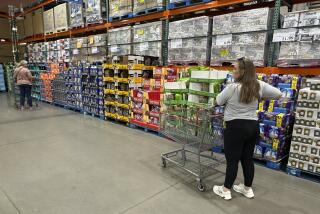Quarterly GDP Revised Upward; Profits Edge Up
- Share via
WASHINGTON — U.S. corporations are weathering the rest of the world’s economic troubles so far--even posting a slight increase in profits for the April-June quarter, but growth in U.S. production of goods and services has slowed sharply, the government said Thursday.
The gross domestic product--the sum of goods and services produced within U.S. borders--increased during the April-June quarter at a seasonally adjusted 1.6% annual rate, the Commerce Department said. That’s down from a torrid 5.5% rate during the year’s first three months.
Advance figures for the second quarter, released last month, had put growth at a slightly lower 1.4% rate, but even the adjusted figure represented the smallest increase in three years.
In its first look at second-quarter profits, the Commerce Department said after-tax earnings rose 0.3% to a seasonally adjusted annual rate of $480.5 billion. That’s a turnaround from falling profitability in the final three months of 1997 and the first three months of this year. But profits are still 1.5% lower than a year ago.
A widening trade deficit is one symptom that global turmoil is affecting the United States.
American exports fell at a 7.4% rate in the second quarter as manufacturers here found less of a market for their products in troubled Asia. Meanwhile, imports surged at a 10% rate as devalued foreign currencies made imported products cheaper for American consumers.
But the trade imbalance wasn’t as bad as first thought. The Commerce Department last month had estimated an 8% decrease in exports and an 11.9% increase in imports.
And U.S. consumers thus far haven’t been seriously hurt by economic problems abroad.
Consumer spending was up at a 5.8% annual rate in the April-June quarter, while inflation remained dormant. A price measure tied to the GDP rose at a tiny 0.8% annual rate, the best since 1963.
Jobs remain at their most plentiful in decades despite slower economic growth. The Labor Department said Thursday that first-time applications for unemployment benefits slipped below 300,000 last week, their lowest level in more than four months.
Also, the Conference Board, a private research group based in New York, said its help-wanted index rose slightly from June to July.
Most analysts expect the economy to continue at a slower pace--around a 2% annual growth rate--for the rest of the year. They don’t think it will slip into decline.
In addition to trade, other big factors restraining economic growth in the second quarter were the General Motors strikes, which idled nearly 200,000 workers from early June through late July, and a slump in production of goods for inventories.
But housing construction was up at a 14.8% annual rate, and businesses increased investment in new equipment, including computers, at an 18.1% rate.
More to Read
Inside the business of entertainment
The Wide Shot brings you news, analysis and insights on everything from streaming wars to production — and what it all means for the future.
You may occasionally receive promotional content from the Los Angeles Times.










